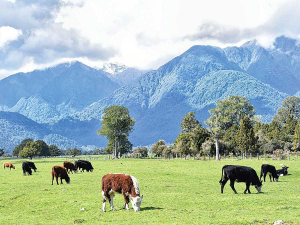Fonterra slashes forecast milk price, again
Fonterra has slashed another 50c off its milk price forecast as global milk flows shows no sign of easing.
 Fonterra says that pasture-based farming is what has kept the New Zealand dairy industry's footprint low.
Fonterra says that pasture-based farming is what has kept the New Zealand dairy industry's footprint low.
Fonterra says new analysis showing New Zealand dairy farms having the lowest carbon footprint in the world is a result of the country’s unique pasture-based farming.
Fonterra director of on-farm excellence, Charlotte Rutherford, says it also reflects the hard graft of the co-operative’s farmer shareholders.
“Which as an employee of the co-op makes me feel pretty proud,” says Rutherford.
“We’ve seen consumers become increasingly interested in the carbon footprint of their products, and today’s report confirms we’re well placed to meet people’s desire for food that’s kinder to the planet.
“We know more needs to be done to keep improving and we’re up for the challenge.”
Innovation is a key part of the co-op’s strategy and it has multiple partnerships to develop the tools and solutions needed to support farmers, particularly in areas where they face tough challenges, such as reducing methane emissions.
“One of the keys to helping guide farmers to continuously improve is ensuring they understand their emissions profiles,” she says.
“Last year, all our farmers received a greenhouse gas emission report specific to their farms. It’s a very practical step toward helping New Zealand meet climate change commitments.”
But finding a solution requires more than just hard graft from the co-op’s farmers and solutions like Kowbucha, seaweed and feed additives are being investigated for potential breakthroughs in reducing emissions from cows. Fonterra has also teamed up with Nestlé and DairyNZ to expand a promising plantain trial to help improve waterways and reduce on-farm greenhouse gas (GHG) emissions.
The report from AgResearch, commissioned by DairyNZ compares New Zealand with 17 other countries. It confirms our footprint is 70% lower than the global average and 46% lower than the average of other countries in the study, which includes all major milk producers.
Legal controls on the movement of fruits and vegetables are now in place in Auckland’s Mt Roskill suburb, says Biosecurity New Zealand Commissioner North Mike Inglis.
Arable growers worried that some weeds in their crops may have developed herbicide resistance can now get the suspected plants tested for free.
Fruit growers and exporters are worried following the discovery of a male Queensland fruit fly in Auckland this week.
Dairy prices have jumped in the overnight Global Dairy Trade (GDT) auction, breaking a five-month negative streak.
Alliance Group chief executive Willie Wiese is leaving the company after three years in the role.
A booklet produced in 2025 by the Rotoiti 15 trust, Department of Conservation and Scion – now part of the Bioeconomy Science Institute – aims to help people identify insect pests and diseases.
President Donald Trump’s decision to impose tariffs on imports into the US is doing good things for global trade, according…
Seen a giant cheese roll rolling along Southland’s roads?